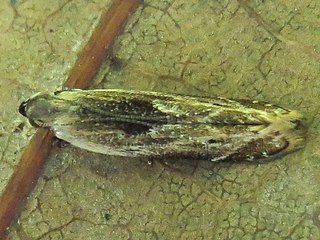Glauce is a genus of moths in the family Gelechiidae. It contains only one species, Glauce pectenalaeella, which is found in North America, where it has been recorded from Alabama, Arkansas, Florida, Illinois, Indiana, Kentucky, Louisiana, Maine, Mississippi, Quebec, South Carolina, Tennessee, Texas and West Virginia.

Parapoynx stratiotata, the ringed china-mark, is a moth of the family Crambidae. The species was first described by Carl Linnaeus in his 1758 10th edition of Systema Naturae. It is found in Europe where the distribution area extends in the north to the British Isles including Ireland and in the south to Sardinia, Sicily and Greece. The species is also found across the Palearctic in North Africa, Lebanon, Turkey, Azerbaijan, Kyrgyzstan, Uzbekistan and China..

Gillmeria pallidactyla is a moth of the family Pterophoridae first described by the English entomologist, Adrian Hardy Haworth in 1811. It has a Holarctic distribution and is widespread throughout North America and the Palearctic.
Hellinsia elliottii is a moth of the family Pterophoridae. It is found in North America, including Mississippi, New York, Iowa, Quebec, Alberta and Ontario.
Hellinsia sulphureodactylus is a moth of the family Pterophoridae. It is found in North America.

Aristotelia roseosuffusella, the pink-washed aristotelia, clover aristotelia moth or garden webworm, is a moth in the family Gelechiidae. It is found in North America, including Alabama, Georgia, Illinois, Kentucky, Maryland, Massachusetts, Michigan, New Jersey, Oklahoma, Ontario, South Carolina, Tennessee and Virginia. The species was first described by James Brackenridge Clemens in 1860.
Bucculatrix improvisa is a moth in the family Bucculatricidae. It was described by Annette Frances Braun in 1963 and is found in North America, where it has been recorded from Ohio.
Elachista stramineola is a moth of the family Elachistidae. It is found in North America, where it has been recorded from California, Alberta, Washington, British Columbia and Montana.
Agonopterix gelidella is a moth in the family Depressariidae. It was described by August Busck in 1908. It is found in North America, where it has been recorded from Alberta, Maine, Manitoba and North Carolina.
Agonopterix hyperella is a moth in the family Depressariidae. It was described by Charles Russell Ely in 1910. It is found in North America, where it has been recorded from Alabama, Indiana, Maryland, Massachusetts, North Carolina, Ohio and Tennessee.

Dichomeris costarufoella is a moth in the family Gelechiidae. It was described by Vactor Tousey Chambers in 1874. It is found in North America, where it has been recorded from Illinois and Louisiana to Nebraska, Oklahoma, Texas, New Mexico, Arkansas and Manitoba.

Agnippe prunifoliella is a moth in the family Gelechiidae. It is found in North America, where it has been recorded from Alabama, Alberta, Arizona, Arkansas, British Columbia, California, Florida, Illinois, Indiana, Kansas, Kentucky, Louisiana, Maine, Maryland, Mississippi, North Carolina, Oklahoma, Quebec, South Carolina, Tennessee, Texas and West Virginia.
Trypanisma prudens is a moth of the family Gelechiidae. It was described by James Brackenridge Clemens in 1860. It is found in North America, where it has been recorded from Alabama, Arkansas, Florida, Illinois, Indiana, Kentucky, Louisiana, Maine, Michigan, Mississippi, Oklahoma, Pennsylvania, South Carolina and Tennessee.
Gnorimoschema gibsoniella is a moth in the family Gelechiidae. It was described by August Busck in 1915. It is found in North America, where it has been recorded from Alberta, Manitoba and Illinois.
Leucogoniella subsimella is a moth of the family Gelechiidae. It was described by James Brackenridge Clemens in 1860. It is found in North America, where it has been recorded from Pennsylvania and Texas.

Aristotelia rubidella is a moth of the family Gelechiidae. It was described by James Brackenridge Clemens in 1860. It is found in North America, where it has been recorded from Alabama, Alberta, Arkansas, British Columbia, California, Florida, Georgia, Illinois, Indiana, Iowa, Kentucky, Louisiana, Maine, Manitoba, Maryland, Massachusetts, Michigan, Mississippi, New Jersey, North Carolina, Ohio, Oklahoma, Ontario, Quebec, South Carolina, Tennessee, Texas, Virginia, Washington, West Virginia and Wisconsin.
Tosca plutonella is a moth of the family Gelechiidae. It was described by Carl Heinrich in 1920. It is found in North America, where it has been recorded from New Mexico.
Monochroa angustipennella is a moth of the family Gelechiidae. It was described by James Brackenridge Clemens in 1863. It is found in North America, where it has been recorded from California, Illinois, Maine, New Jersey, New York, Ohio, Oklahoma and Pennsylvania.

Monochroa gilvolinella is a moth of the family Gelechiidae. It was described by James Brackenridge Clemens in 1863. It is found in North America, where it has been recorded from Illinois, Indiana, Mississippi, New Hampshire and Pennsylvania.
Monochroa robusta is a moth of the family Gelechiidae. It was described by Annette Frances Braun in 1921. It is found in North America, where it has been recorded from Ohio and South Carolina.







